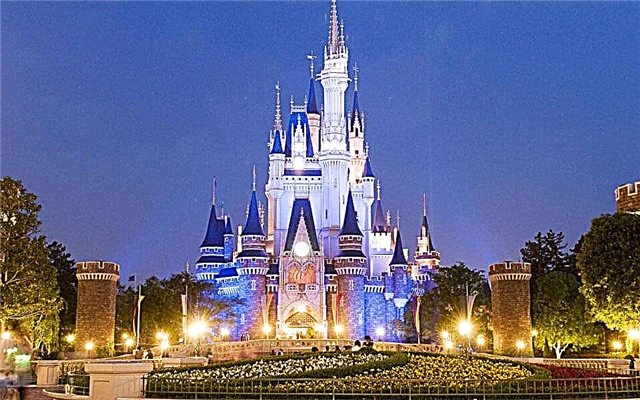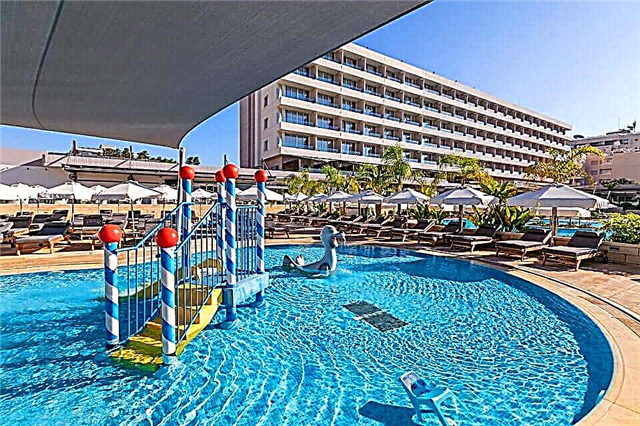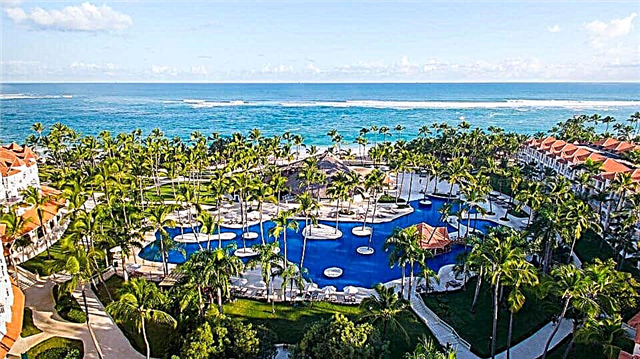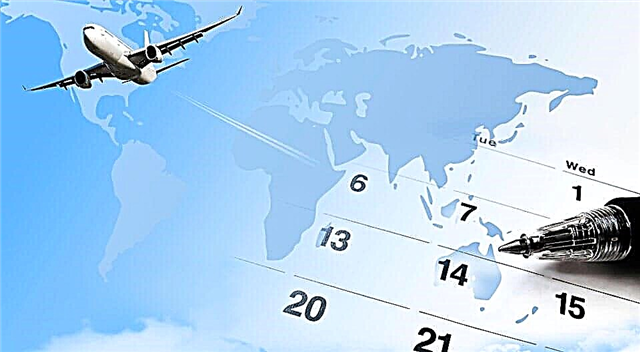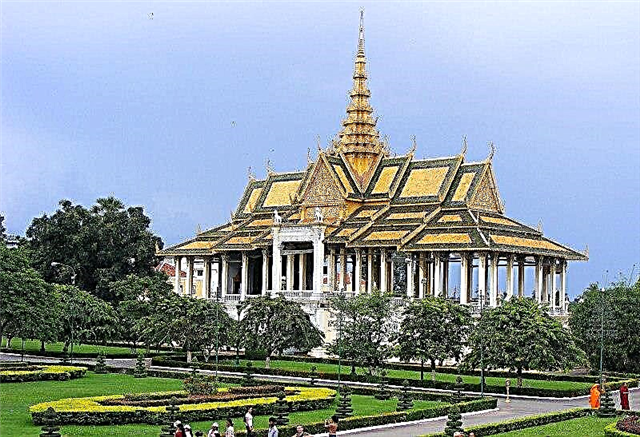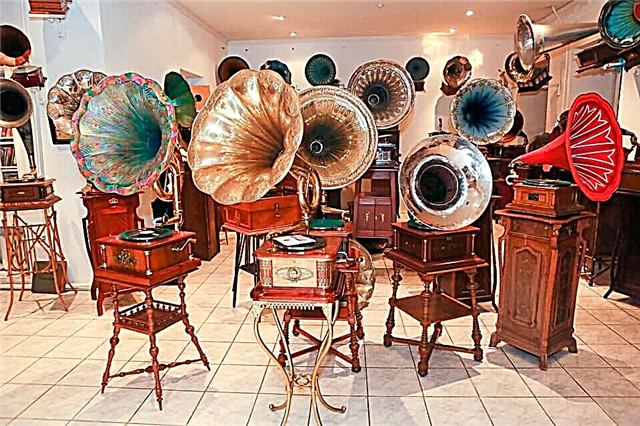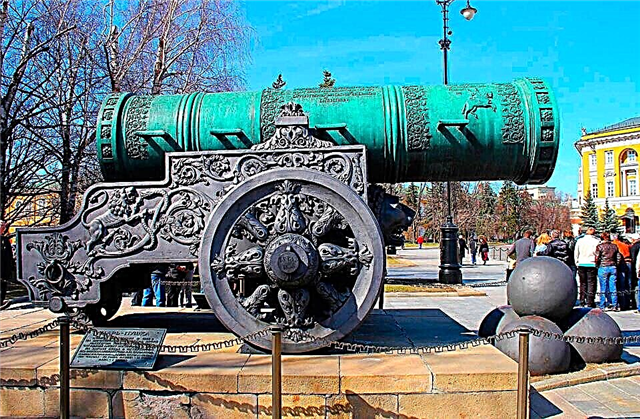In the very center of the capital, there are witnesses of significant events of the past and places where the present takes place - the Kremlin and Red Square. Ancient and unique, beloved and mystical - these places have long become not just business cards of Moscow, but also symbols of the country. Seeing the sights of the Moscow Kremlin and Red Square is task number 1 for any tourist.
Grand Kremlin Palace

One of the capital's business cards known far beyond the borders of the country - the Grand Kremlin Palace - is located along the embankment of the Moskva River. The modern palace was built under Nicholas I by a group of architects led by K.
Tone in place of the once existing structures of the times of Ivan III and Elizabeth Petrovna. The majestic structure is equal in height to a 15-storey building, and in terms of the occupied area it is more than 3 football fields. The complex includes a newly erected palace building, Faceted, Tsaritsyn and Armory, Terem Palace and churches.
The exquisite facade of the palace hides about 700 rooms, including 5 order halls, ceremonial and living quarters of the imperial family and service premises. The main attraction of the palace, which is now the residence of the president, is its luxurious interiors with unique parquet, gilding and marble.
Cathedrals

The Moscow Kremlin is a treasury of Russian art and spirituality. A separate part of it are unique cathedrals, of which only 8 have survived.
St. Basil's Cathedral

The brightest and most unique of the existing temples is St. Basil's Cathedral. The peculiarity of the temple built in 1561 is in unique chapters, none of which repeats the drawing of the other, all 10 are completely different. The temple was not always so colorful.
Initially, the building was made of white stone and brick, and in the 17th century. its domes and walls were decorated with colored patterns. What this is connected with is not known for certain, how and who exactly built the temple. There is a version that the architect was Nikolai Postnik, nicknamed Barma, or they were 2 different people.
The cathedral consists of 10 churches built on one foundation. In the center is the Intercession Church, which gave the cathedral its second name. There are 4 large churches around it, indicating the cardinal points, and 4 more between them. The whole ensemble is surrounded by a bypass gallery.
Cathedral of the Archangel

The Archangel Cathedral stands apart among the Kremlin churches. Built in the XIV century. it will not stand out either for the luxury of the exterior or for the richness of colors. The ceremonial building in the Renaissance style was originally built as a tomb and is dedicated to the archangel, and the features of architecture and the choice of decor elements are subordinate to this.
The five-domed cathedral, according to the tradition of temples erected in honor of archangels and saints, is crowned with silver helmet-shaped domes and only the central dome is a gilded hemisphere. The façade, originally painted to resemble a red brick and later repainted white, is decorated with intact pilasters, capitals, rosettes and arches.
The interior has undergone significant changes. Unique frescoes remained only at the grave of Ivan the Terrible. The sights of the cathedral are the icon depicting the Archangel Michael, and the "Blessed Sky" and 56 burials of princes and kings.
Blagoveshchensky cathedral

Among the many Kremlin churches erected by Italian craftsmen, the Annunciation Cathedral stands out for its architecture. It has become a monument of Russian architecture, combining the features inherent in the Moscow and Pskov schools.
Built as a home church in 1489, the cathedral was completed and decorated until the 1560s, when it acquired its modern look. By this time, the 3-domed cathedral surrounded by porches was replenished with more churches and galleries and now it is crowned with 9 domes.
One of the cathedrals most beloved by princes and tsars is distinguished by luxury from the floor of jasper and agate and the most beautiful iconostasis to the golden cross, which Napoleon never found, and the mechanical clock, the prototype of the Moscow chimes. The cathedral is full of mysteries.
These are tsats - crescents under the crosses of the domes, and miraculous icons. One of the secrets is the images of Greek philosophers on the porch, among other works by the icon painter Edikeev, who was entrusted with painting the temple. Now services are not held in the temple; a museum is located here.
Assumption Cathedral

The Assumption Cathedral is one of the main Moscow churches and undoubtedly one of the most controversial. It is still unknown why the Pskov architects, whose relics lie at the base of the cathedral, and many others, abandoned its construction.
In 1479, on the instructions of Ivan III, the Assumption Cathedral was erected on the site of the temple of I. Kalita, which was destined to become the most important temple for 6 centuries. It was crowned, elevated to dignity, prayers were served, an oath of allegiance was sworn, and state acts were announced. In the Assumption Cathedral, the first of the Romanov family was crowned, and Count L. Tolstoy was excommunicated.
The construction was entrusted to the Italian Catholic Fiorovanti, who coped with the task, erecting the temple, attracting attention with a strict facade and golden helmet-shaped domes. Behind the seeming simplicity of the architecture, there are innovative techniques that have made the cathedral stand out. Now it houses a museum, but festive services are also held.
Ivan the Great belltower

The Ivan the Great Bell Tower is an amazing complex that was built for about 3 centuries, from 1505 to 1815. It included the Assumption Belfry with the Filaret annex and the Ivan the Great Bell Tower itself. The first to appear was the bell tower, which served for 3 adjacent cathedrals.
Then it was slightly lower than it is now. Almost a century later, under Boris Godunov, the last tier was built. With a height of 81 m, the bell tower became the tallest structure in the city, which it remained until the end of the 19th century.
In 1552, the Assumption Church was erected near the bell tower, which was rebuilt into a belfry. In 1624, a Filaretov annex was built near the belfry.
The latter were destroyed during Napoleon's retreat from Moscow, and rebuilt much later. Now museums are located in the bell tower, and going upstairs tourists get to one of the best viewing platforms in the city, from where an amazing view of the Kremlin opens.
Verkhospassky Cathedral

The Verkhnespassky Cathedral cannot be confused with any other - its roof is decorated with 11 drums with golden domes. The temple is a complex of house churches arranged right in the Terem Palace.
The origins of the cathedral go back to the 17th century. to the house churches, when in 1627 the Catherine's Church was built on the female half of the palace. A few years later, the Church of the Savior Not Made by Hands with the chapel of John the Baptist was erected for the tsar and the princes in the male half.
By the middle of the century, the Church of St. Eudokia appears above Catherine's, which will later be re-consecrated in honor of the Resurrection of the Word. And over the side-altar, the Church of the Exaltation of the Lord or the Crucifixion is being erected. Osip Startsev united all the temples during the reconstruction.
Domes were placed on the roof, installed on drums painted with tiles by masters from the New Iersaim Monastery. The appearance of the cathedral has changed little since then, while the interior has lost a lot.
Church of the Twelve Apostles

The Church of the Twelve Apostles is the home church of the hierarchs of the Russian Orthodox Church, which is adjacent to the Patriarchal Palace.
It was built under Patriarch Nikon, who invited the most famous architects and painters to decorate it. Its beauty and wealth, not inferior to the Terem Palace with temples, became the reason for the disgrace of the patriarch. The Church of the Twelve Apostles is the last of the Kremlin's temple structures. Its architecture repeats the elements of the surrounding cathedrals, uniting them into a single ensemble.
After the abolition of the patriarchate, the temple gradually decays. Significant damage was inflicted on it in 1917. Now in the only church in the city dedicated to this holiday, there is a museum, as well as in the palace itself. The unique painting that adorned the walls of the temple has hardly survived, but the richest exhibition of icons is offered to the attention of visitors.
Church of the Laying of the Robe of the Mother of God in Blachernae

The modest one-domed Church of the Position of the Robe of the Mother of God in Wakherna is a memory of the miracle that became possible thanks to the robe of the Mother of God. The Tatars who attacked the Kremlin, the first attack of which the besieged in the Kremlin repulsed, for some reason left, leaving the loot.
In memory of this, a wooden church was erected, which burned down in a fire. Pskov craftsmen in 1486 built a stone church, which became a house for Russian patriarchs and metropolitans. But with the advent of the Temple of the Twelve Apostles, its role changes, it becomes another palace church. It is being rebuilt, the open porches are turned into covered galleries, along which the tsarina follows to the Assumption Cathedral.
The church was badly damaged twice: in a fire in 1737 and shelling in 1918. During the restoration, the wall painting was restored, which, together with the iconostasis, gives the temple a chamber. The gallery of the restored church houses a museum of Russian sculpture.
Museums

In 1991, the eponymous museum-reserve was founded from several state Kremlin museums. It included:
- museums-cathedrals in which exhibitions are located: Arkhangelsk, Annunciation and Assumption
- Church of the Deposition of the Robe, 12 apostles
- bell tower "Ivan the Great"
- Patriarchal and Armory
Armouries

The Armory is a centuries-old heritage of Russian tsars and patriarchs. The first mention of it dates back to 1547, only then it was called the Armory Order, which included the Great Treasury, where all the jewels were kept, the Armory Chamber with weapons, uniforms and banners, the Horse-Stable Order with carriages and the Workshop Chambers.
The modern Armory occupies 2 floors in the Grand Kremlin Palace. Its exposition is located in 9 halls and presents more than 4 thousand exhibits of decorative and applied art.
It displays works by masters not only from Russia and Europe, but also from the East. Among them are a unique collection of thrones, the largest collection of state regalia, rare weapons, art objects of "pre-Mongol" Russia, etc.
The most famous exhibits of the exhibition are the Monomakh hat, Faberge eggs, the throne of Ivan the Terrible, the ceremonial attire of Peter I, etc.
Diamond fund

The Diamond Fund is a separate exposition exhibited in the Armory, which is part of the Gokhran of the Russian Federation. The collection was started by Peter I, who by his decree recognized the treasures in the royal chambers as state treasures.
Coronation regalia, jewelry, if necessary, were issued, and then returned again to the Diamond Cabinet, and then the Armory. After the revolution, many of the fund's precious exhibits were sold out.
Today, the collection of the Diamond Fund consists of about 70 exhibits, including historical stones, gems, diamonds, nuggets, orders and a unique collection of crowns. Visitors will be able to see the famous Orlov diamond, Colombian emerald, 9-kilogram Camel nugget, large and small imperial crowns, etc.
State Historical Museum

The red brick building located in the northwestern part of Red Square attracts attention by its homogeneity with the ensemble of the Moscow Kremlin. The Historical Museum has been located here since 1883, the expositions of which will tell about the history of Russia from ancient times to the present.
On 2 floors of the museum in 39 halls, 22 thousand exhibits are placed in chronological order, which is less than 1% of the total museum fund. Moving from hall to hall, visitors from primitive society find themselves in our days.
Among the exhibits are a canoe carved out of wood, mammoth tusks, a cult structure made of slabs, medieval armor, orders, etc. The museum interiors, on which Aivazovsky, Repin, Korovin and others worked, are also of value.
Towers

The Moscow Kremlin has the shape of a triangle, at the tops of which there are round towers (Beklemishevskaya, Vodovzvodnaya and Uglovaya Arsenalnaya), the other 17 have a rectangular shape. Despite some similarities, all the towers are unique.
The highest is the Troitskaya Tower, the size of which, together with the star, is about 80 m, which is just below the Ivan the Great Bell Tower. The Spasskaya Tower, known by the chimes, is somewhat inferior to it, passing through which one had to dismount and take off their hats.

The smallest and unlike any other is the Tsar's Tower, whose height does not exceed 17 m. It owes its name to Ivan the Terrible, who loves to watch what is happening on Red Square from here. Another unique building is the Kutafya Tower - the only one of the bridgeheads, i.e. not built into the wall.
Each tower is interesting in its own way: Taynitskaya was the first to appear, Corner Arsenalnaya keeps a spring and a dungeon, through Borovitskaya government corteges enter the Kremlin.
Sights

Red Square is the symbol, heart and historical center of Moscow. It is a popular tourist destination with many attractions and is a must-see program.
Zero kilometer

Kilometer zero is a new attraction in Moscow, which appeared only in 1996. The sign was supposed to appear in the capital back in 1985, but they could not decide on the place of installation. This bronze sign shows the origin of distances.
Usually it is located near the main post office, but in Moscow it was decided to place it in the center of tourist routes near the Iverskaya chapel, explaining this by the fact that before the road every Muscovite went to bow to her, asking for her intercession.
The sign is a square divided into 4 parts, symbolizing the parts of the world, inscribed in a circle. Animals are depicted on the bas-relief of the square. In its center there is an eight-pointed icon with an inscription. Despite its youth, the attraction is very popular.
There is a sign: if you stand in the center of the sign facing the chapel on one leg and throw a coin over your left shoulder with your left hand so that it remains within the circle, then your wish will come true.
Resurrection gate

Between the building of the Historical Museum and the City Duma, there are the Resurrection Gate with a double passage through which tourists get to Red Square. The gate was rebuilt in 1995 at the same place where it had been until 1931.
The first gates were built in the 15th century. and were called Lions, tk. a gift from the English king, a cage with lions, was placed in the moat in front of them. Later they changed several more names: Epiphany in honor of the church, Neglimensky because of the bridge across the river, along the nearby courtyards of Trinity and Kuryatnye, until they became Iversky because of the icon that was met here from Athos.
After the restoration, the resurrection of Christ was depicted on them and the gates began to be called the Resurrection. They were demolished as a royal monument, besides, they did not allow large vehicles to enter the square during the parade. A monument to the worker was erected at this place. Now these two-arched gates, built in red brick with white inserts, are one of the visiting cards of the capital.
House of the provincial government

Quite modest against the background of the bright ensemble of Red Square, the building of the provincial government is not striking. Built in the 1730s-40s. according to P. Heyden's project, the building was part of the Kitaygorosky Mint.
Not all of its buildings have survived, on the foundations of some new buildings have been built - the City Duma. The house of the provincial government is a 2-storey building in the Baroque style. Its facade is decorated with graceful pilasters, cornices, projections and putti figurines.In the middle there is a passage gate through which the building of the Old Mint is visible.
Inside the building, ceremonial halls were arranged for ceremonial meetings of public places, later the Moscow Duma was located here. After the revolution, the building had communal apartments for some time. Now the premises of the house are leased to non-profit organizations, some of them are renting a jewelry store.
GUM

GUM is a unique trade city in the historical center of Moscow. The heir to the Upper Chambers of Commerce, a supermarket specializes in luxury goods and occupies an entire block. Trade has always flourished on the square near the Kremlin.
In order to streamline the shops, counters and give the trading place a civilized look, the Trading Rows were first built, which in 1893 was replaced by the passage - the Upper Trading Rows. They existed until 1917, when they were closed as a relic of tsarism.
In 1922 they were opened, but already as GUM, which became a symbol of a new policy, which was destined to work until 1930. The GUM was reopened only in 1953 after the death of Stalin and Beria.
The modern GUM is a shopping and entertainment center that has occupied a historic building in the pseudo-Russian style with a glass roof, under which there are 3 longitudinal and 3 transverse aisles. Products of more than 100 world brands, cinema hall and restaurants are presented here.
Mausoleum of V.I. Lenin

Lenin's Mausoleum is one of the most controversial structures in Moscow. Designed as a ritual burial vault, it has long since become a museum. The mausoleum, which is included in the UNESCO World Heritage List, is the third in a row. The first two were made of wood. The last mausoleum was built in the form of a pyramid of marble, granite, labradorite and quartz. It is a structure 12 m high and 24 m wide.
Inside there are the Funeral Hall with a sarcophagus, in which the body of the leader is kept, and a columbarium, where the ashes of other political figures were supposed to be kept.
The latter is not used and is not shown to visitors. The mausoleum blended into the architecture of Red Square, but still raise a lot of questions: from the choice of the shape of the building itself, to the need for embalming.
Place of execution

One of the sights of Red Square - Execution Ground - is not striking. A small circular elevation 1 m high and 13 m in diameter is surrounded by a stone parapet. The discreet architecture does not attract attention, but the building was of great importance - from here solemn speeches were pronounced and decrees were read, here they were elevated to the kingdom and exhibited the relics of saints, held strikes and exhibited works of art.
Although legends associate this place with public executions. In fact, no one was executed at the Execution Ground; rather, the legends started due to false etymology. The phrase appeared when translating from Hebrew a place in the Gospel, which spoke of the execution at Calvary.
And the Execution Ground is called because of the proximity of the Vasilyevsky Spusk, which in the Middle Ages was called "the forehead". Previously, it was here that tourists threw a coin to return again, now this mission is performed by the Zero Kilometer.
Tsar Cannon

The largest in caliber cannon in the world - the Tsar Cannon - is installed on Ivanovskaya Square between the Church of the 2 Apostles and the Ivan the Great Bell Tower. An outstanding work of artillery art was made at the Cannon Yard by the foundryman A. Chokhov by order of the son of Tsar Ivan the Terrible - Fyodor Ivanovich in 1586.
This is a working weapon, because in the barrel is the stamp of the caster, which was put only after a test shot. The length of this giant is 5 m, and its weight is 40 tons, it took about 200 horses to move it.
On the bronze barrel, surrounded by ornaments, friezes and inscriptions, there is an equestrian image of the king, which gave the name "Tsar Cannon". In 1835, a gun carriage was cast from cast iron at the St. Petersburg factory, which only confirmed the name; it is decorated with the head of the king of animals - a lion.
Researchers argue that the famous giant is not a cannon at all, but a battering bombard. the gun carriage is not designed for her shot. Be that as it may, the Tsar Cannon is one of the achievements of the 16th century.
The Tsar Bell

Another monster of foundry - the Tsar Bell is located on Ivanovskaya Square near the eastern part of the Ivan the Great Bell Tower. Cast by the Motorins family of foundry workers in 1730 by order of Tsarina Anna Ioannovna, the bell never rang, moreover, it was never raised to the bell tower.
The queen wanted to leave the memory of her reign after her predecessors. The Godunov bell, which weighed 33 tons, served less than 50 years and shattered in a fire. The same fate befell the bell, created under Alexei Mikhailovich Romanov, weighing 130 tons.
The Tsar Bell was cast in 1736, however, it was pulled out of the pit only after almost 100 years due to its weight of 200 tons. Only then was a chipped piece of 11 tons discovered. The bell, the height of which reaches 6 m, and the diameter of about 6.6 m, was installed in the place where it stands now. Disputes about the need for restoration do not subside, but there were no attempts to implement it.
Monument to Kuzma Minin and Dmitry Pozharsky

The monument to Minin and Pozharsky is the first large monument in Moscow, erected on Red Square in front of St. Basil's Cathedral. Before that, in honor of important events, temples, arches, etc. were opened. For the 200th anniversary of the Second Militia and the victory of 1612 over the invaders in 1803, it was proposed to create a sculptural composition. She was supposed to portray the leaders of the militia - Prince Dmitry Pozharsky and the headman Kuzma Minin.
It was they who organized the rebuff to the Polish-Lithuanian and Swedish conquerors in Nizhny Novgorod, where the monument was intended. But the monument remained in the capital.
Installed in 1818 in front of the Upper Trading Rows, during the reconstruction of the square it was moved to the cathedral. The monument, the creation of which took 18 tons of copper and brass and was cast at one time, has become a real decoration of the square.
Arsenal

Between the Nikolskaya and Troitskaya towers, the Zeikhgauz or Arsenal is located close to the Kremlin wall. This building, erected by the decree of Peter I in 1736, was supposed to serve not only as a warehouse of weapons, but also as a museum, in which military captured banners, weapons and uniforms were exhibited.
The two-story trapezoidal building with a large courtyard has been under construction for over 30 years. In 1812 it was blown up. Reconstruction work was carried out until 1828. Now its facade is decorated with deep arched windows, arranged in pairs, and friezes.
The height of the Arsenal is more than 30 m, so the Kremlin wall, which does not allow light to penetrate, had to be lowered. In 1819, 875 cannons taken from the French were placed along the building; in 1960, the collection was replenished with cannons that had previously stood at the Armory. The Arsenal itself now houses the administration and the barracks of the Kremlin Commandant's Office.

